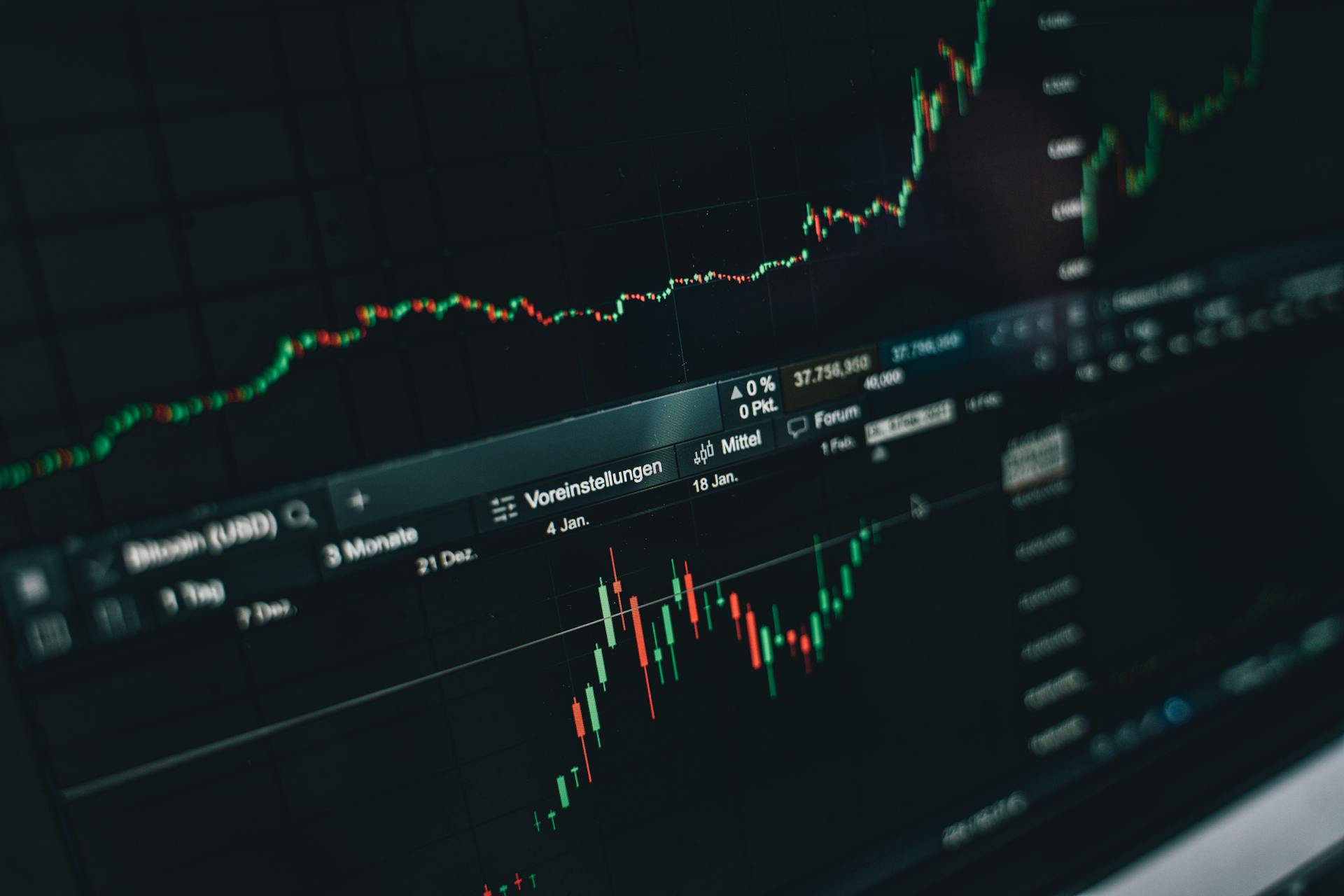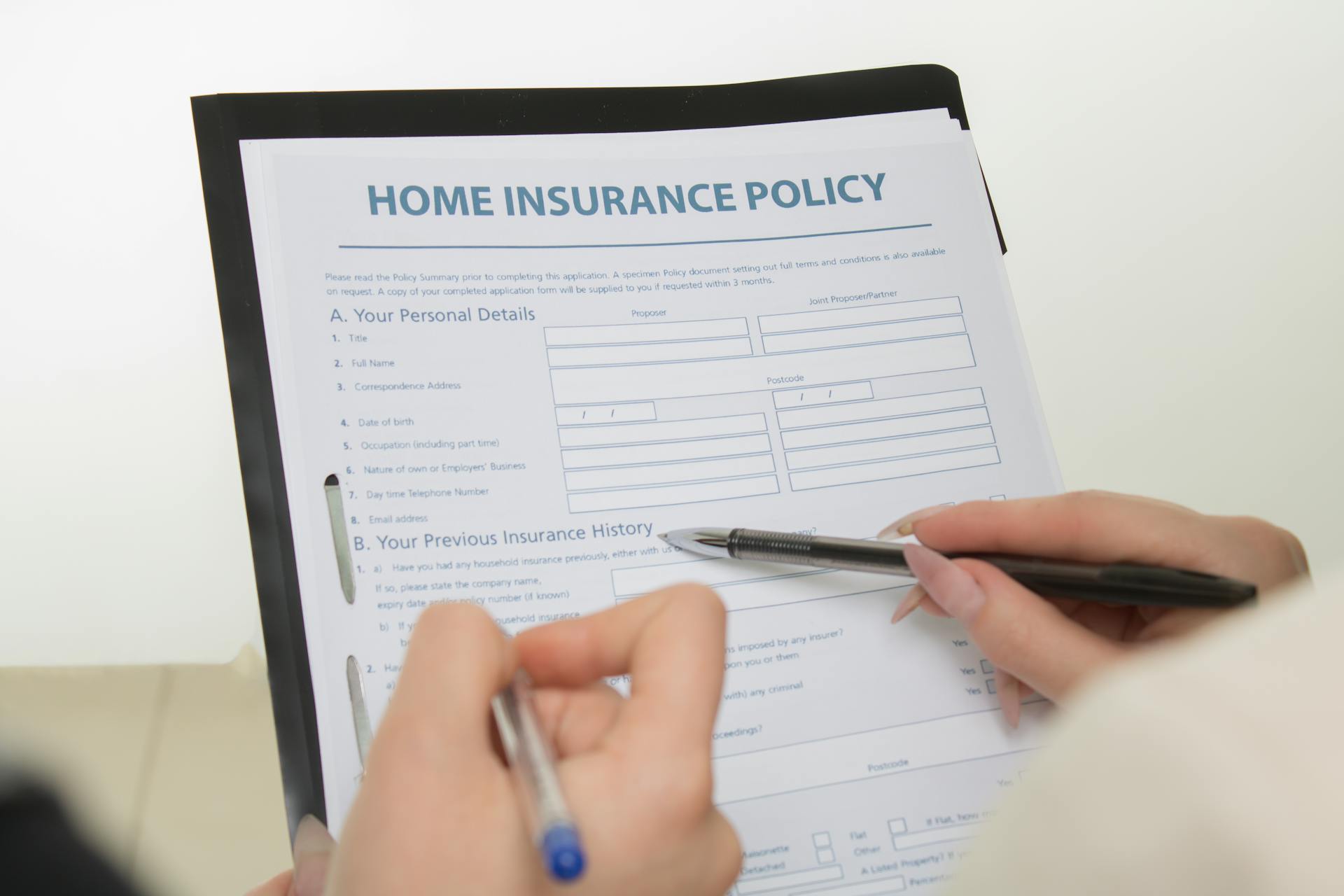
Calculating annual depreciation expense can be a complex process, but it's essential for businesses to accurately record this expense on their financial statements.
The straight-line method is one common approach to determining annual depreciation expense, where the asset's cost is divided by its useful life to calculate the annual expense.
Businesses must also consider the asset's salvage value when calculating depreciation, as it affects the total amount of depreciation expense recorded over the asset's useful life.
The annual depreciation expense is then recorded on the income statement as a non-cash expense, reducing net income.
If this caught your attention, see: Accounting Income Is a Function of
Calculating Depreciation
Calculating depreciation involves understanding key terms like useful life assumption, salvage value, and beginning book value. The useful life assumption is the estimated period an asset is expected to be used by a business, usually measured in years.
To calculate depreciation, you need to determine the annual depreciation expense using the straight line method, which involves subtracting the salvage value from the purchase cost of the asset, then dividing it by the useful life of the asset. This is done by using the formula: Straight Line Depreciation Expense = Purchase Cost - Salvage Value / Useful Life.
You might enjoy: Time Period Assumption Accounting
The straight line depreciation rate can be calculated by dividing the annual depreciation expense by the purchase cost of the asset. For example, if the annual depreciation expense is $1,800 and the purchase cost is $10,000, the straight line depreciation rate would be 0.18 or 18%.
Here's a summary of the key components involved in calculating depreciation:
- Useful life assumption: The estimated period an asset is expected to be used by a business.
- Salvage value: The estimated amount an asset is expected to be worth at the end of its useful life.
- Beginning book value: The value of the asset at the beginning of the year, which is the purchase cost in the first year and the book value at the start of each year after accounting for depreciation.
- Annual depreciation expense: The amount of depreciation expense calculated using the straight line method.
- Straight line depreciation rate: The rate at which an asset depreciates over its useful life.
Cost
Calculating depreciation expense starts with understanding the asset's cost, also known as the initial cost or historical cost.
The asset cost is the foundation for calculating depreciation expense, and it includes the purchase price of the asset, taxes and duties, installation costs, and any other direct costs incurred to bring the asset to working condition.
For example, if you purchase a new delivery truck for $50,000 and spend $2,000 on registration and customization, the total asset cost would be $52,000.
This means that the cost of the asset is the sum of its initial purchase price and any additional costs associated with bringing it into service.
Here are the key components that make up the asset cost:
- Purchase price of the asset
- Taxes and duties
- Installation costs
- Any other direct costs incurred to bring the asset to working condition
These costs are crucial in determining the asset's total cost, which in turn affects the depreciation expense calculation.
Office Furniture
Office furniture can have a varying useful life depending on the material and construction quality, with depreciation reflecting such differences.
The useful life of office furniture can range from a few years to several decades, making it difficult to determine the correct depreciation period.
For example, a high-quality wooden desk might last for 20 years, while a cheaper metal chair might only last for 5 years.
To calculate depreciation for office furniture, you can use the straight-line method, which involves dividing the cost of the furniture by its useful life.
For instance, if you purchase a $1,000 desk that's expected to last for 10 years, the annual depreciation expense would be $100.
Here's a table illustrating the annual depreciation expense for the desk using the straight-line method:
Keep in mind that the units-of-production method can also be used for office furniture, especially if the furniture is expected to be used for a specific number of hours or cycles.
How to Determine
To determine the depreciation of an asset, you need to understand the key terms involved. The useful life assumption is the estimated period over which an asset is expected to be used by a business, usually measured in years.
The salvage value, also known as residual value, is the estimated amount that an asset is expected to be worth at the end of its useful life. This value is crucial in calculating the depreciation expense.
The beginning book value is the value of the asset at the beginning of the year, which is the purchase cost of the asset in the first year, and the book value at the start of each year after accounting for depreciation in subsequent years.
To calculate the straight-line depreciation expense, you need to determine the annual depreciation expense using the straight-line method. This is done by subtracting the salvage value from the purchase cost of the asset, then dividing it by the useful life of the asset.
For another approach, see: Depreciation Expense Straight Line Method
Here's a formula to calculate the straight-line depreciation rate: Straight Line Depreciation Rate = Annual Depreciation Expense/Purchase Cost.
The asset cost, also known as the initial cost or historical cost, is the foundation for calculating depreciation expense. It includes the purchase price of the asset, taxes and duties, installation costs, and any other direct costs incurred to bring the asset to working condition.
A good example of how to determine depreciation using the straight-line method is to calculate the depreciable amount by subtracting the asset's salvage value from its cost, then divide this amount by the asset's useful life. For instance, a $5,000 asset with a salvage value of $500 and a useful life of 5 years would depreciate at $900 per year.
To calculate depreciation through the units of production method, you need to consider the estimated units of production and the actual units produced during the period. The formula is: Depreciation Expense = (Cost of Asset – Salvage Value) / Estimated Units of Production) x Actual Units Produced during the Period.
Here's a summary of the key components involved in calculating depreciation expense:
- Useful life assumption
- Salvage value
- Beginning book value
- Straight-line depreciation rate
- Asset cost
- Estimated units of production
- Actual units produced during the period
Understanding these components will help you calculate depreciation accurately and make informed financial decisions.
Depreciation Methods
Depreciation methods are used to calculate the annual depreciation expense of an asset. The most common methods are the Straight-Line Method, Double Declining Balance, and Sum-of-the-Years’ Digits Method.
The Straight-Line Method spreads the cost of an asset evenly over its useful life, providing consistent expense recognition over the asset’s life. For example, a machine costing $10,000 with a salvage value of $1,000 and a useful life of 5 years would have an annual depreciation expense of $1,800.
The Double Declining Balance method accelerates depreciation, allowing for larger deductions in the early years of an asset’s life. It is suitable for assets that lose value quickly, such as vehicles or technology.
Here's a comparison of the Straight-Line and Double Declining Balance methods:
The Sum-of-the-Years’ Digits Method provides faster depreciation in early years, making it beneficial for tax planning. It is suitable for assets that lose value quickly initially.
The Modified Accelerated Cost Recovery System (MACRS) is a tax depreciation method used in the United States that allows for greater tax deductions in the earlier years of an asset’s life. It is the current tax depreciation system and prescribes specific depreciation periods for different types of assets.
Accelerated depreciation methods, such as Double Declining Balance and Sum-of-the-Years’ Digits, allow businesses to write off asset costs more quickly during the early years of an asset’s life.
Depreciation Calculation
Depreciation Calculation is a crucial aspect of calculating annual depreciation expense. To calculate depreciation expense, you need to determine the annual depreciation expense using the straight line method, which is done by subtracting the salvage value from the purchase cost of the asset, then dividing it by the useful life of the asset.
The straight line method is a simple and widely used method, but there are other methods like units of production and double-declining-balance that can be used depending on the type of asset and its usage pattern.
Discover more: Percentage-of-completion Method
The units of production method ties depreciation to the actual usage of the asset, while the double-declining-balance method accelerates depreciation in the early years of an asset's life. It's essential to choose the method that best reflects the asset's consumption pattern to ensure accurate financial reporting and effective asset management.
Here are some common methods used to calculate depreciation:
- Straight Line Method: (Cost of Asset - Salvage Value) / Useful Life
- Units of Production Method: (Cost of Asset - Salvage Value) / Estimated Units of Production) x Actual Units Produced during the Period
- Double-Declining-Balance Method: 2 times the straight line rate
- Sum-of-the-Years' Digits Method: a more complex method that takes into account the asset's age and remaining useful life
Remember to always consider the salvage value when calculating depreciation, as neglecting it can distort your calculations. Be realistic when estimating salvage value, as overestimating can lead to understated depreciation expense and underestimating can result in overstated depreciation.
Salvage Value
Salvage Value is the estimated amount you expect to receive when disposing of the asset at the end of its useful life.
This could be from selling it or trading it in. For instance, if you estimate that you can sell your delivery truck for $5,000 after its useful life, this would be its salvage value.
Failing to consider salvage value can distort your depreciation calculations. Remember to subtract the estimated salvage value from the asset's cost before calculating depreciation.
Be realistic when estimating salvage value. Overestimating can lead to understated depreciation expense, while underestating can result in overstated depreciation.
Here are some key points to keep in mind when estimating salvage value:
- Overlooking Salvage Value: Remember to subtract the estimated salvage value from the asset's cost before calculating depreciation.
- Unrealistic Salvage Value Estimates: Be realistic when estimating salvage value. Overestimating can lead to understated depreciation expense, while underestimating can result in overstated depreciation.
Office Equipment
Calculating depreciation for office equipment is a straightforward process. You can use the straight-line method to determine the annual depreciation expense.
The straight-line method involves dividing the cost of the equipment by its useful life. For example, if you purchase a new computer for $2,000 and it's expected to last for 5 years with no salvage value, your annual depreciation expense would be $400 per year.
You can also use the straight-line method to calculate the depreciation expense for a delivery van, as seen in Example 5. In this case, the annual depreciation expense would be $3,000 per year.
Take a look at this: An Example of Deferred Revenue Is Unearned Rent
Here are the annual depreciation expenses for a computer and a delivery van using the straight-line method:
Keep in mind that the straight-line method assumes that the equipment loses its value evenly over its useful life. However, in some cases, you may need to use an accelerated method to match the wear and tear of the equipment, as mentioned in Example 4.
Additional reading: How Do You Depreciate Equipment
Financial Reporting and Accounting
Depreciation expense can significantly impact how your financial statements appear. The straight-line method provides steady depreciation expenses, which can lead to more consistent reported earnings over time.
Different depreciation methods can affect the timing and amount of depreciation expense recognized on the income statement, which in turn impacts net income. The chosen method determines the depreciation deductions, which can influence tax liability.
A steady depreciation expense can make a company's financial performance appear more consistent, but it's essential to consider how your company's financial performance will be perceived by stakeholders.
Curious to learn more? Check out: For a Firm That Must Pay Income Taxes Depreciation Expense
Financial Statements
Financial statements are a crucial part of financial reporting, and understanding how depreciation expenses appear in them is essential for business owners to accurately interpret their company's financial health.
Depreciation expense directly affects your company's profitability as reported on the income statement. It appears as an operating expense, typically listed under "Selling, General, and Administrative Expenses" or as a separate line item.
The impact of depreciation expense on profit is significant, as it reduces your reported net income, even though it doesn't involve an actual cash outflow. This is because depreciation is a non-cash expense.
Depreciation is recorded as an expense on the income statement, which reduces the net income for the period it's accounted for. The expense is matched to the revenue generated by the use of the asset, adhering to the matching principle.
Here's a breakdown of how depreciation expense appears on the income statement:
- Location: Operating expense, typically listed under "Selling, General, and Administrative Expenses" or as a separate line item.
- Impact on profit: Reduces reported net income.
- Non-cash nature: Doesn't affect cash flow in the period it's recorded.
Cash Flows
When preparing a company's financial reports, it's essential to understand the cash flow statement. Depreciation expense plays a unique role in this statement, as it's a non-cash expense that's added back to net income when calculating cash flow from operations.
On a similar theme: Cash Net Realizable Value
This add-back helps reconcile net income (accrual basis) to actual cash flow (cash basis). The cash flow statement is a crucial document that provides insight into a company's liquidity and ability to meet its financial obligations.
Here's a breakdown of how depreciation affects the cash flow statement:
- Operating Activities: Depreciation is added back to net income when calculating cash flow from operations.
- Reconciliation: This add-back helps reconcile net income (accrual basis) to actual cash flow (cash basis).
- Cash flow impact: By adding back depreciation, you can see that it doesn’t directly affect your company’s cash position.
In practical terms, this means that depreciation doesn't directly impact a company's cash flow. It's a non-cash expense that's accounted for on the balance sheet, but it doesn't affect the company's ability to pay its bills or meet its financial obligations.
Recommended read: T Account Debit Credit
Financial Ratios
Depreciation expenses can significantly influence various financial ratios, making it essential to understand how they impact different types of ratios.
Profitability ratios, such as the return on equity (ROE) and return on assets (ROA), are affected by depreciation expenses. This is because depreciation is a non-cash expense that reduces net income, which in turn affects these ratios.
Asset turnover ratios, on the other hand, are influenced by depreciation expenses in a more indirect way. Depreciation can affect the cost of goods sold, which is a key component of the asset turnover ratio.
Here's a breakdown of how depreciation affects different financial ratios:
Understanding the impact of depreciation on financial ratios is crucial for making informed business decisions and accurately assessing a company's financial performance.
Related reading: Difference between Financial Accounting and Management Accountant
Accounting Calculation Tools
Depreciation methods are used to spread the cost of an asset across its useful life. The straight-line method is one of the most common methods, where the asset's cost is divided by its useful life.
The straight-line method is simple to calculate, as seen in the example where Liam's silk screen machine costs $10,000 and has a useful life of five years. This results in a depreciation cost of $1,800 per year.
The units-of-production method is another common method, where the asset's cost is divided by the total number of units it can produce. This method is useful for assets that have a limited lifespan based on usage, such as a machine that can only print a certain number of items.
Intriguing read: Is Straight Line Depreciation a Fixed Cost
For Liam's silk screen machine, the units-of-production method results in a depreciation cost of $0.09 per press, with a higher expense in the second year due to the increased number of clothing items produced.
The double-declining-balance method is a more aggressive method that accelerates depreciation in the early years of an asset's life. This method is calculated by doubling the straight-line rate, resulting in a higher depreciation expense in the first year.
In the example, Liam's silk screen machine has a first-year expense of $4,000 under the double-declining-balance method, with a lower expense in the second year.
Common Mistakes and Considerations
Accurately calculating depreciation expense is crucial for maintaining proper financial records and making informed decisions.
Failing to consider salvage value can distort your depreciation calculations. This is a common pitfall many people overlook.
To avoid this, remember to subtract the estimated salvage value from the asset's cost before calculating depreciation. Be realistic when estimating salvage value, as overestimating can lead to understated depreciation expense, while underestimating can result in overstated depreciation.
Here are some key considerations to keep in mind:
- Overlooking Salvage Value: This can lead to inaccurate depreciation calculations.
- Unrealistic Salvage Value Estimates: Be sure to estimate salvage value accurately to avoid understated or overstated depreciation expenses.
Inconsistent Application

Inconsistent application of depreciation methods can lead to a host of problems. It's essential to maintain consistency in your depreciation methods to ensure accurate financial reporting.
Switching depreciation methods for similar assets without a valid reason can raise red flags and complicate your financial reporting. This is a common mistake, and it's crucial to avoid it.
Using different methods for book and tax purposes is allowed, but it's essential to keep accurate records of both calculations to avoid confusion. This will help you stay organized and ensure that your financial records are accurate.
Here are some key considerations to keep in mind when applying depreciation methods consistently:
Maintaining consistency in your depreciation methods will help you avoid these common mistakes and ensure that your financial records are accurate and reliable.
Inaccurate Life Estimation
Accurately estimating an asset's useful life is crucial for calculating depreciation expense. This is because incorrect estimates can significantly impact your financial records and decision-making.
Overestimating an asset's useful life can lead to understated depreciation expense and overstated asset value on the balance sheet. On the other hand, underestimating useful life results in overstated depreciation expense and understated asset value.
It's essential to familiarize yourself with standard useful life estimates for different types of assets in your industry. This will help you make more accurate assessments and avoid common pitfalls.
Here's a quick reference guide to common mistakes in estimating useful life:
Remember, estimating useful life is an uncertain process, and it's common to make mistakes. However, being aware of these potential issues will help you take steps to avoid them and maintain accurate financial records.
Frequently Asked Questions
What is a depreciation expense example?
Depreciation expense is calculated by dividing the total asset cost by its useful life, resulting in a fixed annual expense. For example, a $50,000,000 building used for 25 years would have an annual depreciation expense of $2,000,000.
Sources
- https://www.highradius.com/resources/Blog/double-declining-balance-depreciation/
- https://www.costanalysts.com/glossary/depreciation-expense/
- https://openstax.org/books/principles-financial-accounting/pages/11-3-explain-and-apply-depreciation-methods-to-allocate-capitalized-costs
- https://www.bookstime.com/articles/depreciation-expense
- https://accountingforeveryone.com/how-to-calculate-depreciation-in-bookkeeping/
Featured Images: pexels.com


